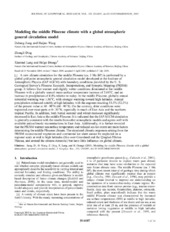| dc.description.abstract | A new climate simulation for the middle Pliocene (ca. 3 Ma BP) is performed by a global grid-point atmospheric general circulation model developed at the Institute of Atmospheric Physics (IAP AGCM) with boundary conditions provided by the U. S. Geological Survey's Pliocene Research, Interpretations, and Synoptic Mapping (PRISM) group. It follows that warmer and slightly wetter conditions dominated at the middle Pliocene with a globally annual mean surface temperature increase of 2.60°C, and an increase in precipitation of 4.0% relative to today. At the middle Pliocene, globally annual terrestrial warming was 1.86°C, with stronger warming toward high latitudes. Annual precipitation enhanced notably at high latitudes, with the augment reaching 33.5% (32.5%) of the present value at 60–90°N (60–90°S). On the contrary, drier conditions were registered over most parts at 0–30°N, especially in much of East Asia and the northern tropical Pacific. In addition, both boreal summer and winter monsoon significantly decreased in East Asia at the middle Pliocene. It is indicated that the IAP AGCM simulation is generally consistent with the results from other atmospheric models and agrees well with available paleoclimatic reconstructions in East Asia. Additionally, it is further revealed that the PRISM warmer sea surface temperature and reduced sea ice extent are main factors determining the middle Pliocene climate. The simulated climatic responses arising from the PRISM reconstructed vegetation and continental ice sheet cannot be neglected on a regional scale at mid to high latitudes (like over Greenland and the Qinghai-Tibetan Plateau, and around the circum-Antarctic) but have little influence on global climate. | en_US |
